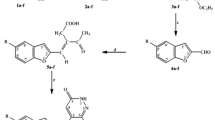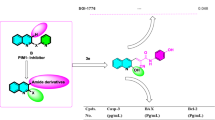Abstract
Natural and chemically synthesized heterocyclic compounds have been explored for their potential use as anticancer agents. We had synthesized non-natural heterocyclic analogs and evaluated their anti-tumor activity by measuring effect on cell proliferation and induction of apoptosis in different cell lines. Previously, we identified a pyrazole-containing compound (G-11) showing cytotoxic effect towards leukemia and lymphoma cell lines. In this study, we further investigated the mechanistic aspects of anticancer properties of G-11 in HL-60 cell line. We demonstrated that cytotoxic effect of G-11 is mediated by caspase-dependent apoptosis. However, the involvement of mitochondrial dysfunction induced by G-11 was independent of caspases. G-11 triggered generation of ROS, caused disruption of mitochondrial transmembrane potential, increased release of cytochrome c to the cytosol, and altered the expression of Bcl-2 and Bax proteins. These results suggest significant involvement of intrinsic apoptotic pathway. This study comprehensively details the possible mechanisms of action of a novel heterocyclic compound which could find its potential use as an anticancer agent.






Similar content being viewed by others
Abbreviations
- G-11:
-
[1-(2′′,3′′,4′′,6′′-Tetra-O-acetyl-β-D-glucopyranosyl)-4-(3′-trifluoromethylphenyl hydrazono)-3-trifluoromethyl-1,4-dihydropyrazol-5-one]
- HL-60:
-
Human acute myelogenous leukemia cell line
- ∆ψm :
-
Difference in mitochondrial transmembrane potential
- ROS:
-
Reactive oxygen species
- VDAC:
-
Voltage dependent anion channel
- Bcl-2:
-
B-cell lymphoma 2
- Bcl-xL:
-
B-cell lymphoma-extra-large
- Bax:
-
Bcl-2-associated X protein
- Bak:
-
Bcl-2 homologous antagonist killer
- PARP:
-
Poly (ADP-ribose) polymerase
- 7-AAD:
-
7-amino-actinomycin D
- PDTC:
-
Pyrrolidine dithiocarbamate
- NAC:
-
N-Acetyl cysteine
- z-VAD-FMK:
-
N-Benzyloxycarbonyl-Val-Ala-Asp-fluoromethyl ketone
- Necrostatin-1:
-
[5-(1H-Indol-3-ylmethyl)-3-methyl-2-thioxo-4-Imidazolidinone, 5-(Indol-3-ylmethyl)-3-methyl-2-thio-Hydantoin, MTH-DL-Tryptophan]
- DMSO:
-
Dimethyl sulfoxide
- PMSF:
-
Phenylmethanesulfonyl fluoride
- Ac-LEHD-pNA:
-
N-acetyl-Leu-Glu-His-Asp-p-nitroanilide
- Ac-IETD-pNA:
-
N-acetyl-Ile-Glu-Thr-Asp-p-nitroanilide
- Ac-DEVD-pNA:
-
N-acetyl-Asp-Glu-Val-Asp-p-nitroanilide
- PVDF:
-
Polyvinylidene fluoride
References
Ali I, Lone MN, Al-Othman ZA, Al-Warthan A, Sanagi MM (2015) Heterocyclic scaffolds: centrality in anticancer drug development. Curr Drug Targets 16:711–734
Martins P, Jesus J, Santos S, Raposo LR, Roma-Rodrigues C, Baptista PV et al (2015) Heterocyclic anticancer compounds: recent advances and the paradigm shift towards the use of nanomedicine’s tool box. Molecules 20:16852–16891
Bryson HM, Sorkin EM (1993) Cladribine. A review of its pharmacodynamic and pharmacokinetic properties and therapeutic potential in haematological malignancies. Drugs 46:872–894
Robertson LE, Huh YO, Butler JJ, Pugh WC, Hirsch-Ginsberg C, Stass S et al (1992) Response assessment in chronic lymphocytic leukemia after fludarabine plus prednisone: clinical, pathologic, immunophenotypic, and molecular analysis. Blood 80:29–36
Ross SR, McTavish D, Faulds D (1993) Fludarabine. A review of its pharmacological properties and therapeutic potential in malignancy. Drugs 45:737–759
Leoni LM, Chao Q, Cottam HB, Genini D, Rosenbach M, Carrera CJ et al (1998) Induction of an apoptotic program in cell-free extracts by 2-chloro-2′-deoxyadenosine 5′-triphosphate and cytochrome c. Proc Natl Acad Sci USA 95:9567–9571
Ewald B, Sampath D, Plunkett W (2008) Nucleoside analogs: molecular mechanisms signaling cell death. Oncogene 27:6522–6537
Enari M, Sakahira H, Yokoyama H, Okawa K, Iwamatsu A, Nagata S (1998) A caspase-activated DNase that degrades DNA during apoptosis, and its inhibitor ICAD. Nature 391:43–50
Mukae N, Enari M, Sakahira H, Fukuda Y, Inazawa J, Toh H et al (1998) Molecular cloning and characterization of human caspase-activated DNase. Proc Natl Acad Sci USA 95:9123–9128
Samejima K, Tone S, Kottke TJ, Enari M, Sakahira H, Cooke CA et al (1998) Transition from caspase-dependent to caspase-independent mechanisms at the onset of apoptotic execution. J Cell Biol 143:225–239
Marchetti P, Castedo M, Susin SA, Zamzami N, Hirsch T, Macho A et al (1996) Mitochondrial permeability transition is a central coordinating event of apoptosis. J Exp Med 184:1155–1160
Tan TT, Degenhardt K, Nelson DA, Beaudoin B, Nieves-Neira W, Bouillet P et al (2005) Key roles of BIM-driven apoptosis in epithelial tumors and rational chemotherapy. Cancer Cell 7:227–238
Abdou IM, Saleh AM, Zohdi HF (2004) Synthesis and antitumor activity of 5-trifluoromethyl-2,4- dihydropyrazol-3-one nucleosides. Molecules 9:109–116
Ikezoe T, Yang J, Nishioka C, Tasaka T, Taniguchi A, Kuwayama Y et al (2007) A novel treatment strategy targeting Aurora kinases in acute myelogenous leukemia. Mol Cancer Ther 6:1851–1857
Keen N, Taylor S (2009) Mitotic drivers—inhibitors of the Aurora B kinase. Cancer Metastasis Rev 28:185–195
Yang J, Ikezoe T, Nishioka C, Tasaka T, Taniguchi A, Kuwayama Y et al (2007) AZD1152, a novel and selective aurora B kinase inhibitor, induces growth arrest, apoptosis, and sensitization for tubulin depolymerizing agent or topoisomerase II inhibitor in human acute leukemia cells in vitro and in vivo. Blood 110:2034–2040
Perchellet EM, Ward MM, Skaltsounis AL, Kostakis IK, Pouli N, Marakos P et al (2006) Antiproliferative and proapoptotic activities of pyranoxanthenones, pyranothioxanthenones and their pyrazole-fused derivatives in HL-60 cells. Anticancer Res 26:2791–2804
Judson IR (1991) Anthrapyrazoles: true successors to the anthracyclines? Anticancer Drugs 2:223–232
Saleh AM, Taha MO, Aziz MA, Al-Qudah MA, AbuTayeh RF, Rizvi SA (2016) Novel anticancer compound [trifluoromethyl-substituted pyrazole N-nucleoside] inhibits FLT3 activity to induce differentiation in acute myeloid leukemia cells. Cancer Lett 375:199–208
Abad MJ, Bedoya LM, Apaza L, Bermejo P (2012) The artemisia L. genus: a review of bioactive essential oils. Molecules 17:2542–2566
Saleh AM, Aljada A, El-Abadelah MM, Sabri SS, Zahra JA, Nasr A et al (2015) The pyridone-annelated isoindigo (5′-Cl) induces apoptosis, dysregulation of mitochondria and formation of ROS in leukemic HL-60 cells. Cell Physiol Biochem 35:1958–1974
Gong J, Traganos F, Darzynkiewicz Z (1994) A selective procedure for DNA extraction from apoptotic cells applicable for gel electrophoresis and flow cytometry. Anal Biochem 218:314–319
Masoud L, Vijayasarathy C, Fernandez-Cabezudo M, Petroianu G, Saleh AM (2003) Effect of malathion on apoptosis of murine L929 fibroblasts: a possible mechanism for toxicity in low dose exposure. Toxicology 185:89–102
Saleh AM, El-Abadelah MM, Aziz MA, Taha MO, Nasr A, Rizvi SA (2015) Antiproliferative activity of the isoindigo 5′-Br in HL-60 cells is mediated by apoptosis, dysregulation of mitochondrial functions and arresting cell cycle at G0/G1 phase. Cancer Lett 361:251–261
Cossu A, Posadino AM, Giordo R, Emanueli C, Sanguinetti AM, Piscopo A et al (2012) Apricot melanoidins prevent oxidative endothelial cell death by counteracting mitochondrial oxidation and membrane depolarization. PLoS One 7:e48817
Salvioli S, Ardizzoni A, Franceschi C, Cossarizza A (1997) JC-1, but not DiOC6(3) or rhodamine 123, is a reliable fluorescent probe to assess delta psi changes in intact cells: implications for studies on mitochondrial functionality during apoptosis. FEBS Lett 411:77–82
She MR, Li JG, Guo KY, Lin W, Du X, Niu XQ (2007) Requirement of reactive oxygen species generation in apoptosis of leukemia cells induced by 2-methoxyestradiol. Acta Pharmacol Sin 28:1037–1044
Saleh AM, Vijayasarathy C, Masoud L, Kumar L, Shahin A, Kambal A (2003) Paraoxon induces apoptosis in EL4 cells via activation of mitochondrial pathways. Toxicol Appl Pharmacol 190:47–57
Adams JM, Cory S (2002) Apoptosomes: engines for caspase activation. Curr Opin Cell Biol 14:715–720
Groninger E, Meeuwsen-De Boer GJ, De Graaf SS, Kamps WA, De Bont ES (2002) Vincristine induced apoptosis in acute lymphoblastic leukaemia cells: a mitochondrial controlled pathway regulated by reactive oxygen species? Int J Oncol 21:1339–1345
Keter FK, Darkwa J (2012) Perspective: the potential of pyrazole-based compounds in medicine. Biometals 25:9–21
Kuwana T, Newmeyer DD (2003) Bcl-2-family proteins and the role of mitochondria in apoptosis. Curr Opin Cell Biol 15:691–699
Wang XD, Gu LQ, Wu JY (2007) Apoptosis-inducing activity of new pyrazole emodin derivatives in human hepatocellular carcinoma HepG2 cells. Biol Pharm Bull 30:1113–1116
Yang J, Liu X, Bhalla K, Kim CN, Ibrado AM, Cai J et al (1997) Prevention of apoptosis by Bcl-2: release of cytochrome c from mitochondria blocked. Science 275:1129–1132
Sampath D, Rao VA, Plunkett W (2003) Mechanisms of apoptosis induction by nucleoside analogs. Oncogene 22:9063–9074
Saleh A, Srinivasula SM, Acharya S, Fishel R, Alnemri ES (1999) Cytochrome c and dATP-mediated oligomerization of Apaf-1 is a prerequisite for procaspase-9 activation. J Biol Chem 274:17941–17945
Luchi K, Hatano Y, Yagura T (2008) Heterocyclic organobismuth(III) induces apoptosis of human promyelocytic leukemic cells through activation of caspases and mitochondrial perturbation. Biochem Pharmacol 76:974–986
Huang H, Shah K, Bradbury NA, Li C, White C (2014) Mcl-1 promotes lung cancer cell migration by directly interacting with VDAC to increase mitochondrial Ca2+ uptake and reactive oxygen species generation. Cell Death Dis 5:e1482
Bebbington D, Binch H, Charrier JD, Everitt S, Fraysse D, Golec J et al (2009) The discovery of the potent aurora inhibitor MK-0457 (VX-680). Bioorg Med Chem Lett 19:3586–3592
Reddy GL, Guru SK, Srinivas M, Pathania AS, Mahajan P, Nargotra A et al (2014) Synthesis of 5-substituted-1H-pyrazolo[4,3-d]pyrimidin-7(6H)-one analogs and their biological evaluation as anticancer agents: mTOR inhibitors. Eur J Med Chem 80:201–208
Gamal-Eldeen AM, Hamdy NA, Abdel-Aziz HA, El-Hussieny EA, Fakhr IM (2014) Induction of intrinsic apoptosis pathway in colon cancer HCT-116 cells by novel 2-substituted-5, 6, 7, 8-tetrahydronaphthalene derivatives. Eur J Med Chem 77:323–333
Shin SY, Yoon H, Hwang D, Ahn S, Kim D-W, Koh D et al (2013) Benzochalcones bearing pyrazoline moieties show anti-colorectal cancer activities and selective inhibitory effects on aurora kinases. Bioorg Med Chem 21:7018–7024
Ge D, Kong X, Liu W, Zhao J, Su L, Zhang S et al (2013) Phosphorylation and nuclear translocation of integrin β4 induced by a chemical small molecule contribute to apoptosis in vascular endothelial cells. Apoptosis 18:1120–1131
Liu X, Wilcken R, Joerger AC, Chuckowree IS, Amin J, Spencer J et al (2013) Small molecule induced reactivation of mutant p53 in cancer cells. Nucleic Acids Res 41:6034–6044
Toton E, Ignatowicz E, Bernard MK, Kujawski J, Rybczynska M (2013) Evaluation of apoptotic activity of new condensed pyrazole derivatives. J Physiol Pharmacol 64:115–123
Huang YT, Pan SL, Guh JH, Chang YL, Lee FY, Kuo SC et al (2005) YC-1 suppresses constitutive nuclear factor-kappaB activation and induces apoptosis in human prostate cancer cells. Mol Cancer Ther 4:1628–1635
Ding XL, Zhang HY, Qi L, Zhao BX, Lian S, Lv HS et al (2009) Synthesis of novel pyrazole carboxamide derivatives and discovery of modulators for apoptosis or autophagy in A549 lung cancer cells. Bioorg Med Chem Lett 19:5325–5328
Acknowledgments
This project is supported by a research Grant from King Abdulaziz City for Science and Technology (KACST; Grant Number- AT-34-136, Riyadh, Kingdom of Saudi Arabia) for Saleh A.M. Publication cost is supported by King Abdullah International Medical Research Center (KAIMRC) in Riyadh, Saudi Arabia.
Author information
Authors and Affiliations
Corresponding author
Electronic supplementary material
Below is the link to the electronic supplementary material.
Rights and permissions
About this article
Cite this article
Saleh, A.M., Aziz, M.A., Abdou, I.M. et al. Cytotoxic activity of the novel heterocyclic compound G-11 is primarily mediated through intrinsic apoptotic pathway. Apoptosis 21, 873–886 (2016). https://doi.org/10.1007/s10495-016-1248-z
Published:
Issue Date:
DOI: https://doi.org/10.1007/s10495-016-1248-z




